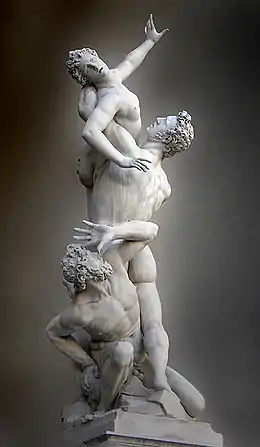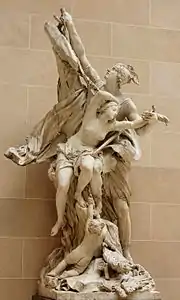Abduction of a Sabine Woman
Abduction of a Sabine Woman (or Rape of the Sabine Women) is a large and complex marble statue by the Flemish sculptor and architect Giambologna (Johannes of Boulogne). It was completed between 1579 and 1583[1] when Giambologna was a student at the prestigious Accademia delle Arti del Disegno, Rome, under he patronage of Cosimo I de' Medici.[2] Giambologna achieved widespread fame in his lifetime, and this work is widely considered his masterpiece.[3] It has been in the Loggia dei Lanzi, Florence, since August 1582.[4]

The statue is composed in the figura serpentina style. It depicts three nude figures: a young man in the center who has seemingly taken a woman from an despairing older man below him. It is ostensibly based on the rape of the Sabine Women incident from the early history of Rome when the city contained relatively few women, leading to their men committing a raptio (large-scale abduction; the word is rendered as rape in archaic or literary English) of young women from nearby towns and cities.
It was the first of Giambologna's statues for Francesco de’ Medici of Tuscany,[5] and is produced in the Mannerist style[6] associated with the Italian High Renaissance. It consists of three full figures and was carved from a single block of white marble. It was not given a title until after it was completed.[7] Giambologna was typically non-committal about the subject matter of his work, and in this instance wanted to produce a large, monumental sculpture that would display his virtuosity.[2] Around the time it was finished, and before Francesco had it installed at the Loggia dei Lanzi, Vincenzo Borghini suggest the title The Rape of the Sabines,[3] and thus a bronze relief was added to the pedestal to link it with the Roman myth.[4]
Title and subject
The statue intended for Francesco de’ Medici of Tuscany, not by commission, but rather to impress the influential Medici, for whom the artist later produced a number of works, thereby establishing his career and reputation.[8] Giambologna was more interested in technique and sculptural form than story-telling or history painting, and typically named his works only late in their completion.[9] His working titles for this statue at various times included Paris and Helen, Pluto and Proserpina and Phineus and Andromeda, although the naming was not a matter he was preoccupied with. According to the art historian John Shearman, the statue was "an experiment in form rather than content", and typical of its time, "the expression of artistic qualities".[10] The historian Charles Avery agreed with this, describing it as "purely as a compositional exercise".[10] Avery went on to say that Giambologna'a "lack of concern with specific subject matter or deep emotional expression...left him free to concentrate on the technical aspect, extending his virtuosity to the limits of the materials with which he worked."[11]

As its completion drew near, Giambologna was in need of a title and requested input from a number of writers. The Italian monk, philologist and art collector Vincenzo Borghini suggested the title La Rappia delle Sabine (The Plunder of the Sabine Maidens).[8] According to the art historian Michael Cole, the title may fit in someway, but is essentially unsatisfactory or perhaps meaningless as it does not convey the artist's real intent. According to Cole "the scene...conforms with what one would expect in a depiction of the Sabines, but nothing there really clarifies theidentities of the characters".[8]

Borghini himself realised the contextual limitations of his title but, nevertheless wrote that Giambologna "thus depicted the aforementioned Sabine maiden as the young woman who is being lifted up; her abductor represents Talassius. Even if he did not himself take her in public, his men took her for him, and he took her in private, stealing her virginity. And the old man below represents her father, since the story, as I have said, tells that the Romans robbed the Sabines from the arms of their father."[12] On this reading the work is sometimes compared to Donatello's stark and brutal Judith and Holofernes, located at the Loggia dei Lanzi from 1506 to 1919.[13]
In the context of the ledged of the Sabine Women, the titular word 'rape' is based on the classical Roman term raptio, which roughly translates as "mass kidnap" rather than the modern English term, hence the recent trend of titling the work, more accurately, the abduction of a (singular) Sabine Woman.
Description
The Abduction of a Sabine Woman was made from a single block of white marble, which became the largest block ever transported to Florence. Giambologna wanted to create a composition with the figura serpentina (S-curve) and an upward snakelike spiral movement. It was conceived without a dominant viewpoint; that is, the work gives a different view depending on which angle it is seen from.[14]
At 410 cm in height, the statue is larger than life-sized, adding to its monumental impact. It depicts three nude figures: an old man crouching at the end, a young man in the center who lifts a young woman above his head. The woman, who reaches her right hand outwards grasping for help, is in a life-threatening struggle to free herself from her captor. The old man appears to be defeated and in despair. Only half of his body is visible and from some angles this is evidently because the younger man's feet and knees are violently pushing and keeping him down. The three figures' heads are at opposites regardless of view point; in particular the old man seems is always turned away from the younger woman, as he realises he has lost her to the aggressor, and thus his facial contortions are probably to be read as from shame.[15]
 Detail of the female figure
Detail of the female figure Rear view of the young man
Rear view of the young man Frontal view with background
Frontal view with background
Giambologna was ambitious and competitive, and hoped to equal a number of his influences, including Michelangelo's 1501-04 David now in the Accademia Gallery, and Baccio Bandinelli's 1525-34 Hercules and Cacus at the Piazza della Signoria; both in Florence.[16]
The pedestal contains a bas-relief inscription OPVS IOANNIS BOLONII FLANDRI MDLXXXII (The work of Johannes of Boulogne of Flanders, 1582).[17]
Studies, condition
The original plaster cast model is now in the Galleria dell'Accademia.[3] A bronze model dated c. 1479 is in the Metropolitan Museum of Art, New York.[18]
The sculpture was restored in 2001 and again in 2007.
Influence
The statue was widely influential and is though to have informed works such as The kidnapping of Proserpina by Gian Lorenzo Bernini (1621-22), Laocoon by Adriaen de Vries (1623) and Pierre Puget's Perseus and Andromeda (1684), among many others.
 The kidnapping of Proserpina, Gian Lorenzo Bernini, 1621–22. Galleria Borghese, Rome
The kidnapping of Proserpina, Gian Lorenzo Bernini, 1621–22. Galleria Borghese, Rome Laocoon, Adriaen de Vries, 1623. Wallenstein Palace, Prague
Laocoon, Adriaen de Vries, 1623. Wallenstein Palace, Prague Perseus and Andromeda, Pierre Puget, 1684. Musée du Louvre, Paris
Perseus and Andromeda, Pierre Puget, 1684. Musée du Louvre, Paris
References
Notes
- Start dates as late as 1581 have also been suggested. See Cole (2008), p.340
- Janson; Janson (2013), p.42
- "Rape of the Sabines by Jean de Boulogne". Accademia.org. Retrieved 15 November 2020
- Pritchard, Shannon. "Giambologna, Abduction of a Sabine Woman". Khan Academy. Retrieved 15 November 2020
- "Giambologna's bronze statuette of the rape of a Sabine: which will be sold at Christie's great rooms on Tuesday 5 December 1989". London: Christie's, 1989
- "Rape of the Sabines". J. Paul Getty Museum. Retrieved 15 November 2020
- Universal History of Art, Volume VI (1984), p. 783
- Cole (2008), p. 341
- Cole (2008), p. 337
- Even (1991), p. 12
- Avery, Charles. "Giambologna". University of California Press. p. 1. Retrieved 15 November 2020
- Cole (2008), p. 342
- Even (1991), pp. 11-12
- Harris (2014), p. 86
- Cole (2008), p. 345
- Cole (2008), p. 344
- Avery; Finn (1994), p. 254
- "Abduction of a Sabine Woman". Metropolitan Museum of Art. Retrieved 15 November 2020
Sources
- Ardigo, Achill. The statues of the Loggia della Signoria in Florence. Giunti Editore, 2012. ISBN 978-8-8090-2620-9
- Avery, Charles; Finn, David. Giambologna: The Complete Sculpture. NY: Phaidon Press, 1994. ISBN 978-0-7148-2953-1
- Carroll, Margaret. "The Erotics of Absolutism: Rubens and the Mystification of Sexual Violence". Representations, No. 25, Winter 1989. pp. 3-30. JSTOR 2928464
- Cole, Michael. "Giambologna and the Sculpture with No Name". Oxford Art Journal, vol. 31, No. 3, 2008. pp. 339–359. JSTOR 20542849
- Even, Yael. "The Loggia dei Lanzi: A Showcase of Female Subjugation". Woman's Art Journal, volume 12, No. 1, Spring-Summer 1991. pp. 10–14. JSTOR 1358184
- Harris, Ann. Seventeenth-Century Art & Architecture. London: Laurence King Publishing, 2014. ISBN 978-1-8566-9415-5
- Janson, Horst Woldemar; Janson, Anthony. History of Art: The Western Tradition. NJ: Prentice-Hall, 2013. ISBN 978-0-1318-2895-7
- Rudigier, Alexander. Giambologna: Court Sculptor to Ferdinando I. London: Ad Ilissum, 2019. ISBN 978-1-912168-14-9
- Universal history of art, Volume VI: Baroque and Rococo. Madrid: SARPE, 1984. ISBN 978-8-4729-1594-7